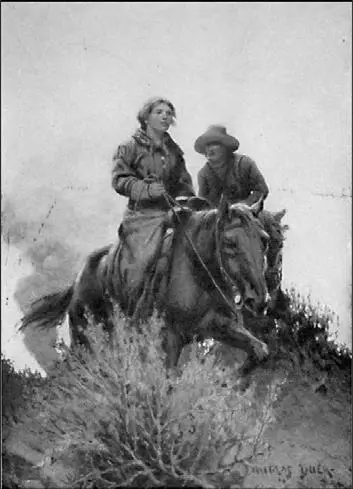Zane Grey

r i d e r s o f
t h e p u r p l e s a g e

“Dont Look Back!”
r i d e r s o f
t h e p u r p l e s a g e
A Novel
Zane Grey
Introduction By Greg Beatty PhD.
Illustrated By Douglas Duer
Barnes & Noble World Digital Library New York
Introduction Copyright © 2002 by Barnes & Noble World Digital Library
First Published 1912
All rights reserved under International and Pan-American Copyright Conventions.
Published in the United States by Barnes & Noble World Digital Library, New York.
Barnes & Noble World Digital Library and colophon are trademarks of Barnes & Noble.com.
Barnes & Noble.com, 76 Ninth Avenue, New York, NY 10011.
Cover Design by Paul Kezmarsky and Red Canoe Cover Photograph © PhotoDisc
ISBN 0-594-08883-6
i n t r o d u c t i o n
In Zane Grey’s most celebrated work, Riders of The
Purple Sage, he creates a world of purity, excitement, and delight, where “old-fashioned” values are celebrated, work is admired, and adventure waits around every bend. Not only will readers find gun-fights, lost loves, stampedes, love affairs, hearts torn by religious doubt, and political maneuverings, they will also discover the American western wilderness rendered in rich detail. Published in 1912, Riders was an immediate bestseller and heralded a whole new genre.
Born in 1872, Pearl Zane Grey was raised in Zanesville, Ohio, a town founded by his mother's ancestors. Grey liked outdoor activities, and his most common hobbies were fishing and playing baseball. His passion for the American West was aroused in 1907, when Grey had an opportunity to tour the West with Buffalo Jones, a long-time hunter and adventurer. Under Jones’ guidance, Grey traveled through the desert, chased wild horses, and v
introduction
hunted cougars. His journals of the time were filled with glowing passages about the beauty of the land.
Grey’s writing about the West bears the fire of a convert. He came to love the land as an adult, and this gives him a crucial spark. The land is always the largest character in Grey’s books, a semi-divine entity beyond human comprehension. A mark of Grey’s heroes—both male and female—is their recognition of the power of nature, and their appreciation of its wonders.
Grey consciously rejected modernism’s rising dominance as a literary movement and preferred instead the thematic structure of the romance.
Riders of the Purple Sage bears the earmarks of this structure, with star-crossed lovers and characters of moral extremity and purity (for good or ill). It is this thematic structure that has made Grey’s books both so popular and so criticized. While some modernists rejected, even ridiculed Grey’s roman-ticism, Northrop Frye argues that the romance is a semi-independent tradition, with roots in antiquity that run through the gothic novel and the melodrama. Formally and socially, the romance is conservative, eschewing experimentation, and contented to work within inherited patterns. In part, the function of the romance is to assert the continuity of the world as it has always been.
Herein lies the strength of Grey’s work: minutely researched, his books can be used as textbooks—so vi
introduction
meticulous are they in their history, geography, and ecology—yet people can simply read and enjoy them for their adventure.
Grey was not the first to rework the American West into the romance tradition; John Cawelti points out this tendency in the work of James Fenimore Cooper as well as Owen Wister, both of whom wrote about the natural nobility of men in the wilderness. While they often described the wilderness in detail, and their heroes were at home there, nature was not always a friendly place for Cooper or Wister. Indeed, it was often threatening.
However, Grey brought several new elements to these patterns of nineteenth century melodrama that made his work especially appealing.
Grey introduced a profound love of nature; his love for the land did not remain the simple affection of the sportsman or tourist, but deepened over time and with research. In Man of the Forest (1920), Grey criticized government policies interfering with the balance of nature, and defended the need to let eco-logical systems go undisturbed as much as possible.
1 comment